Bonn
| Bonn | |||
|---|---|---|---|
|
Beethoven Monument, Villa Hammerschmidt, Old City Hall, Poppelsdorf Palace, panoramic view over Bonn and the Electoral Palace, now seat of the University of Bonn (clockwise from top left). | |||
| |||
 Bonn | |||
| Coordinates: 50°44′02.37″N 7°5′59.33″E / 50.7339917°N 7.0998139°ECoordinates: 50°44′02.37″N 7°5′59.33″E / 50.7339917°N 7.0998139°E | |||
| Country | Germany | ||
| State | North Rhine-Westphalia | ||
| Admin. region | Cologne | ||
| District | Urban district | ||
| Founded | 1st century BC | ||
| Government | |||
| • Lord Mayor | Ashok-Alexander Sridharan (CDU) | ||
| Area | |||
| • Total | 141.06 km2 (54.46 sq mi) | ||
| Population (2015-12-31)[1] | |||
| • Total | 318,809 | ||
| • Density | 2,300/km2 (5,900/sq mi) | ||
| Time zone | CET/CEST (UTC+1/+2) | ||
| Postal codes | 53111–53229 | ||
| Dialling codes | 0228 | ||
| Vehicle registration | BN | ||
| Website | www.bonn.de | ||
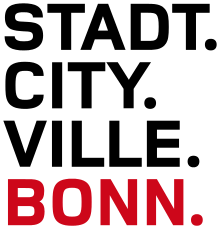
The Federal City of Bonn (German pronunciation: [ˈbɔn]) is a city on the banks of the Rhine in the German state of North Rhine-Westphalia, with a population of 311,287. Bonn is in the southernmost part of the Rhine-Ruhr region, Germany's largest metropolitan area, with over 11 million inhabitants.
Founded in the first century BC as a Roman settlement, Bonn is one of Germany's oldest cities. From 1597 to 1794, Bonn was the capital of the Electorate of Cologne and residence of the Archbishops and Prince-electors of Cologne. In 1949, the Parliamentary Council drafted and adopted the German constitution, the Basic Law for the Federal Republic of Germany in Bonn. Though Berlin was symbolically named the de jure capital, from 1949 to 1990 Bonn was the seat of government and de facto capital of West Germany. From 1990 to 1999, Bonn served as the seat of government of reunited Germany. In recognition of its former status as German capital, it holds the name of Federal City (Bundesstadt). Bonn currently shares the status of Germany's seat of government with Berlin, with the President, the Chancellor and many government ministries maintaining substantial presences in Bonn.
The two DAX-listed corporations Deutsche Post DHL and Deutsche Telekom have headquarters in Bonn. The city is also the location of 19 United Nations institutions and the University of Bonn. Bonn is the birthplace of Ludwig van Beethoven (born 1770).
Climate
Bonn has an oceanic climate (Cfb). In the south of the Cologne lowland in the Rhine valley, Bonn is in one of Germany's warmest regions.
| Climate data for Bonn | |||||||||||||
|---|---|---|---|---|---|---|---|---|---|---|---|---|---|
| Month | Jan | Feb | Mar | Apr | May | Jun | Jul | Aug | Sep | Oct | Nov | Dec | Year |
| Daily mean °C (°F) | 2.4 (36.3) |
2.8 (37) |
6.3 (43.3) |
9.7 (49.5) |
14.0 (57.2) |
16.7 (62.1) |
18.8 (65.8) |
18.3 (64.9) |
14.6 (58.3) |
10.5 (50.9) |
6.2 (43.2) |
3.1 (37.6) |
10.3 (50.5) |
| Average rainfall mm (inches) | 61.0 (2.402) |
54.0 (2.126) |
64.0 (2.52) |
54.0 (2.126) |
72.0 (2.835) |
86.0 (3.386) |
78.0 (3.071) |
78.0 (3.071) |
72.0 (2.835) |
63.0 (2.48) |
66.0 (2.598) |
68.0 (2.677) |
816.0 (32.126) |
| Mean monthly sunshine hours | 51.0 | 76.0 | 110.0 | 163.0 | 190.0 | 195.0 | 209.0 | 194.0 | 141.0 | 104.0 | 55.0 | 41.0 | 1,529 |
| Source: Deutscher Wetterdienst (Bonn-Rohleber, period 1971- 2010) | |||||||||||||
History
History before 1945


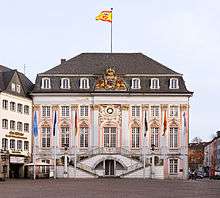
The history of the city dates back to Roman times. In about 12 BC, the Roman army appears to have stationed a small unit in what is presently the historical centre of the city. Even earlier, the army had resettled members of a Germanic tribal group allied with Rome, the Ubii, in Bonn. The Latin name for that settlement, "Bonna", may stem from the original population of this and many other settlements in the area, the Eburoni. The Eburoni were members of a large tribal coalition effectively wiped out during the final phase of Caesar's War in Gaul. After several decades, the army gave up the small camp linked to the Ubii-settlement. During the 1st century AD, the army then chose a site to the north of the emerging town in what is now the section of Bonn-Castell to build a large military installation dubbed Castra Bonnensis, i.e., literally, "Fort Bonn". Initially built from wood, the fort was eventually rebuilt in stone. With additions, changes and new construction, the fort remained in use by the army into the waning days of the Western Roman Empire, possibly the mid-5th century. The structures themselves remained standing well into the Middle Ages, when they were called the Bonnburg. They were used by Frankish kings until they fell into disuse. Eventually, much of the building materials seem to have been re-used in the construction of Bonn's 13th-century city wall. The Sterntor (star gate) in the city center is a reconstruction using the last remnants of the medieval city wall.
To date, Bonn's Roman fort remains the largest fort of its type known from the ancient world, i.e. a fort built to accommodate a full-strength Imperial Legion and its auxiliaries. The fort covered an area of approximately 250,000 square metres (62 acres). Between its walls it contained a dense grid of streets and a multitude of buildings, ranging from spacious headquarters and large officers' quarters to barracks, stables and a military jail. Among the legions stationed in Bonn, the "1st", i.e. the Prima Legio Minervia, seems to have served here the longest. Units of the Bonn legion were deployed to theatres of war ranging from modern-day Algeria to what is now the Russian republic of Chechnya.
The chief Roman road linking the provincial capitals of Cologne and Mainz cut right through the fort where it joined the fort's main road (now, Römerstraße). Once past the South Gate, the Cologne–Mainz road continued along what are now streets named Belderberg, Adenauerallee et al. On both sides of the road, the local settlement, Bonna, grew into a sizeable Roman town.
In late antiquity, much of the town seems to have been destroyed by marauding invaders. The remaining civilian population then took refuge inside the fort along with the remnants of the troops stationed here. During the final decades of Imperial rule, the troops were supplied by Franci chieftains employed by the Roman administration. When the end came, these troops simply shifted their allegiances to the new barbarian rulers, the Kingdom of the Franks. From the fort, the Bonnburg, as well as from a new medieval settlement to the South centered around what later became the minster, grew the medieval city of Bonn. Local legends arose from this period that the name of the village came from Saint Boniface via Vulgar Latin *Bonnifatia, but this proved to be a myth.
Between the 11th and 13th centuries, the Romanesque style Bonn Minster was built, and in 1597 Bonn became the seat of the Archdiocese of Cologne. The city gained more influence and grew considerably. The city was subject to a major bombardment during the Siege of Bonn in 1689. The elector Clemens August (ruled 1723–1761) ordered the construction of a series of Baroque buildings which still give the city its character. Another memorable ruler was Max Franz (ruled 1784–1794), who founded the university and the spa quarter of Bad Godesberg. In addition he was a patron of the young Ludwig van Beethoven, who was born in Bonn in 1770; the elector financed the composer's first journey to Vienna.
In 1794, the city was seized by French troops, becoming a part of the First French Empire. In 1815 following the Napoleonic Wars, Bonn became part of the Kingdom of Prussia. Administered within the Prussian Rhine Province, the city became part of the German Empire in 1871 during the Prussian-led unification of Germany. Bonn was of little relevance in these years.
History since 1945
During World War II, Bonn acquired military significance because of its strategic location on the Rhine River, which formed a natural barrier to easy penetration into the German heartland from the west. The Allied ground advance into Germany reached Bonn on 7 March 1945, and the US 1st Infantry Division captured the city during the battle of 8–9 March 1945.[2]
Following World War II, Bonn was in the British zone of occupation, and in 1949 became the de facto capital of the newly formed Federal Republic of Germany (the de jure capital of the Federal Republic throughout the years of the Cold War division of Germany was always Berlin). Such "provisional" capital cities have been common in history; for example, the "official" capital of the Republic of China is still Nanjing on mainland China, with Taipei considered the provisional capital.[3] The choice of Bonn was made mainly due to the advocacy of West Germany's first chancellor, Konrad Adenauer, a former Cologne Mayor and a native of that area. This was despite the fact that Frankfurt already had most of the required facilities and using Bonn was estimated to be 95 million DM more expensive than using Frankfurt. However, Adenauer and other prominent politicians intended to make Berlin the capital of the reunified Germany, and felt that locating the capital in a major city like Frankfurt or Hamburg would imply a permanent capital and weaken support in West Germany for reunification.
Because of its relatively small size for a capital city, Bonn was sometimes referred to, jokingly, as the Bundeshauptstadt ohne nennenswertes Nachtleben (Federal capital without noteworthy nightlife) or the Bundesdorf (Federal Village).[4] At one point in the post-WWII/Cold War era, the U.S. Embassy in Bonn was America's largest, "comparable, with its thousands of staff, to the [U.S.] Baghdad embassy today".[5]
German reunification in 1990 made Berlin the nominal capital of Germany again. This decision did not mandate that the republic's political institutions would also move. While some argued for the seat of government to move to Berlin, others advocated leaving it in Bonn—a situation roughly analogous to that of the Netherlands, where Amsterdam is the capital but The Hague is the seat of government. Berlin's previous history as united Germany's capital was strongly connected with Imperial Germany, the Weimar Republic and more ominously with Nazi Germany. It was felt that a new peacefully united Germany should not be governed from a city connected to such overtones of war. Additionally, Bonn was closer to Brussels, headquarters of the European Union.
The heated debate that resulted was settled by the Bundestag (Germany's parliament) only on 20 June 1991. By a vote of 338–320,[6] the Bundestag voted to move the seat of government to Berlin. The vote broke largely along regional lines, with legislators from the south and west favouring Bonn and legislators from the north and east voting for Berlin.[7][8] It also broke along generational lines as well; older legislators with memories of Berlin's past glory favoured Berlin, while younger legislators favoured Bonn. Ultimately, the votes of the Ossi legislators tipped the balance in favour of Berlin.[9]
While the government and parliament moved to Berlin, as a compromise, some of the ministries (such as Defence and Agriculture) largely remained in Bonn, with only the top officials based in Berlin. There was no plan to move these departments, and so Bonn remained a second, unofficial capital with the new title "Federal City" (Bundesstadt). Because of the necessary construction work, the move took until 1999 to complete. Over 8,000 of the 18,000 federal officials remain in Bonn.[10]
At present, the private sector plays a major role in Bonn's economy. With five stock listed companies, Bonn has the fourth highest market capitalisation among German cities. With headquarters of DHL, T-Mobile and other renowned companies, managers have replaced the public sector.

Main sites
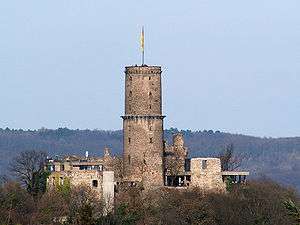


Beethoven's birthplace is located in Bonngasse near the market place. Next to the market place is the Old City Hall, built in 1737 in Rococo style, under the rule of Clemens August of Bavaria. It is used for receptions of guests of the city, and as an office for the mayor. Nearby is the Kurfürstliches Schloss, built as a residence for the prince-elector and now the main building of the University of Bonn.
The Poppelsdorfer Allee is an avenue flanked by chestnut trees which had the first horsecar of the city. It connects the Kurfürstliches Schloss with the Poppelsdorfer Schloss, a palace that was built as a resort for the prince-electors in the first half of the 18th century, and whose grounds are now a botanical garden (the Botanischer Garten Bonn). This axis is interrupted by a railway line and Bonn Hauptbahnhof, a building erected in 1883/84.
The Beethoven Monument stands on the Münsterplatz, which is flanked by the Bonn Minster, one of Germany's oldest churches.
The three highest buildings in the city are the radio mast of WDR in Bonn-Venusberg (180 m), the headquarters of the Deutsche Post called Post Tower (162.5 m) and the former building for the German members of parliament Langer Eugen (114.7 m) now the new location of the UN Campus.
Churches
- Bonn Minster[11]
- Doppelkirche Schwarzrheindorf built in 1151
- Old Cemetery Bonn, one of the best known ones in Germany[12]
- Kreuzbergkirche, built in 1627 with Johann Balthasar Neumann's Heilige Stiege, it is a stairway for Christian pilgrims[13]
Castles and residences
Modern buildings
- Beethovenhalle
- Bundesviertel (federal quarter) with lots of government structures including
- Post Tower, the tallest building in the state North Rhine-Westphalia, housing the headquarters of Deutsche Post/DHL
- Maritim Bonn, five-star hotel and convention centre
- Schürmann-Bau, headquarters of Deutsche Welle
- Langer Eugen, since 2006 the centre of the United Nations Campus, formerly housing the offices of the members of the German parliament
- Deutsche Telekom headquarters
- T-Mobile headquarters
- Kameha Grand, five-star hotel
Museums
- Museum Mile with
- Kunst- und Ausstellungshalle der Bundesrepublik Deutschland (Art and Exhibition Hall of the Federal Republic of Germany), showing the Guggenheim Collection in 2006–2007[16]
- Kunstmuseum Bonn (Bonn Museum of Modern Art)[17]
- Haus der Geschichte (Museum of the History of the Federal Republic of Germany)[18]
- Museum Koenig where the Parlamentarischer Rat first met[19]
- Beethoven House, birthplace of Ludwig van Beethoven[20]
- Rheinisches Landesmuseum Bonn (Rhinish Regional Museum Bonn)[21]
- Bonn Women's Museum
- August-Macke-Haus, museum dedicated to Expressionist painter August Macke
- Arithmeum
Nature
- Arboretum Park Härle, an arboretum with specimens dating to 1870
- Botanischer Garten (Botanical Garden), where Titan arum set a world record[22]
- Rheinaue (Bonn), a leisure park on the banks of the Rhine[23]
- Kottenforst, a large area of protected woods on the hills west of the city centre[24]
- Rhine promenade and the Alter Zoll (Old Toll Station)
- In the very south of the city, on the border with Wachtberg and Rhineland-Palatinate, is an extinct volcano the Rodderberg
Education

The Rheinische Friedrich Wilhelms Universität Bonn (University of Bonn) is one of the largest universities in Germany. It is also the location of the German research institute Deutsche Forschungsgemeinschaft (DFG) offices and of the German Academic Exchange Service (Deutscher Akademischer Austauschdienst – DAAD).
Private schools
- Aloisiuskolleg, a Jesuit private school in Bad Godesberg with boarding facilities
- Amos-Comenius-Gymnasium, a Protestant private school in Bad Godesberg
- Bonn International School (BIS), a private English-speaking school set in the former American Compound in the Rheinaue, which offers places from kindergarten to 12th grade. It follows the curriculum of the International Baccalaureate.
- King Fahd Academy (DE), a private school in Mehlem, Bad Godesberg, which also includes a mosque
- Libysch Schule, private Arabic high school
- Independent Bonn International School, (IBIS) private primary school (serving from kindergarten, reception, and years 1 to 6)
- École de Gaulle - Adenauer, private French-speaking school serving grades pre-school ("maternelle") to grade 4 (CM1)
- Ernst-Kalkuhl-Gymnasium (DE), private boarding and day school
- Otto-Kühne-Schule Godesberg ("PÄDA") (DE), private day school
- Collegium Josephinum Bonn ("CoJoBo") (DE), private day school
- Akademie fuer Internationale Bildung, private higher educational facility offering programs for international students Additionally there are six private Catholic schools.
- Jugenddorf-Christophorusschule Königswinter (CJD), private Christian school serving grades Kindergarten to 13[25]
Districts
In 1969, the independent towns of Bad Godesberg and Beuel as well as several villages were incorporated into Bonn, resulting in a city more than twice as large as before. Bad Godesberg and Beuel became districts (Stadtbezirke) of Bonn with some independence and populations of about 70,000 each.
Each district has its own quarters:
- Bad Godesberg: Alt-Godesberg, Friesdorf, Godesberg-Nord, Godesberg-Villenviertel, Heiderhof, Hochkreuz, Lannesdorf, Mehlem, Muffendorf, Pennenfeld, Plittersdorf, Rüngsdorf, Schweinheim
- Beuel: Beuel-Mitte, Beuel-Ost, Geislar, Hoholz, Holtorf, Holzlar, Küdinghoven, Limperich, Oberkassel, Pützchen/Bechlinghoven, Ramersdorf, Schwarzrheindorf/Vilich-Rheindorf, Vilich, Vilich-Müldorf
- Bonn: Auerberg, Bonn-Castell (until 2003: Bonn-Nord), Bonn-Zentrum, Buschdorf, Dottendorf, Dransdorf, Endenich, Graurheindorf, Gronau, Ippendorf, Kessenich, Nordstadt, Poppelsdorf, Röttgen, Südstadt, Tannenbusch, Ückesdorf, Venusberg, Weststadt
- Hardtberg: Brüser Berg, Duisdorf, Hardthöhe, Lengsdorf, Lessenich/Meßdorf
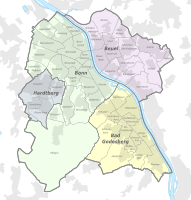 Districts of Bonn
Districts of Bonn
 The town hall in Hardtberg
The town hall in Hardtberg Carnival in Bonn
Carnival in Bonn Offices of Deutsche Welle
Offices of Deutsche Welle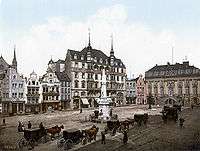 Bonn Old Town Hall and marketplace, circa 1900. The market fountain can be seen in the foreground.
Bonn Old Town Hall and marketplace, circa 1900. The market fountain can be seen in the foreground.
Transport
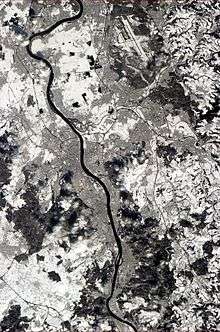
Bonn is connected to three autobahns (federal motorways) and the German rail network. Some InterCityExpress and most InterCity trains call at Bonn Hauptbahnhof whilst the Siegburg/Bonn railway station is situated on the Cologne–Frankfurt high-speed rail line outside of Bonn and serviced by InterCityExpress trains. Local transport is provided by the Bonn Stadtbahn, which also features two lines to Cologne.
Bonn's international airport is Cologne Bonn Airport.
Demographics
As of 2011, Bonn had a population of 327,913. About 70% of the population was entirely of German origin, while about 100,000 people, equating to roughly 30%, were at least partly of non-German origin. The city is one of the fastest-growing municipalities in Germany and the 18th most populous city in the country. Bonn's population is predicted to surpass the populations of Wuppertal and Bochum before the year 2030.[26]
The following list shows the largest groups of foreign residents in Bonn as of 2015 by nationalities.[27]
| Rank | Nationality | Population (2015) |
|---|---|---|
| 1 | 8,370 | |
| 2 | 7,390 | |
| 3 | 5,705 | |
| 4 | 4,652 | |
Economy
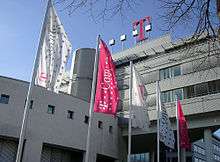
The head offices of Deutsche Telekom, its subsidiary T-Mobile,[28] Deutsche Post, Haribo, German Academic Exchange Service, and SolarWorld are in Bonn.
Sports
Bonn is home of the Telekom Baskets Bonn, the only basketball club in Germany that owns its arena, the Telekom Dome.[29] The club is a regular participant at international competitions such as the Eurocup.
The city also has an amateur football team Bonner SC which was formed in 1965 through the merger of Bonner FV and Tura Bonn.
International relations
Since 1983, the City of Bonn has established friendship relations with the City of Tel Aviv, Israel, and since 1988 Bonn, in former times the residence of the Princes Electors of Cologne, and Potsdam, Germany, the formerly most important residential city of the Prussian rulers, have established a city-to-city partnership.
Central Bonn is surrounded by a number of traditional towns and villages which were independent up to several decades ago. As many of those communities had already established their own contacts and partnerships before the regional and local reorganisation in 1969, the Federal City of Bonn now has a dense network of city district partnerships with European partner towns.
The city district of Bonn is a partner of the English university city of Oxford, England, UK (since 1947), of Budafok, District XXII of Budapest, Hungary (since 1991) and of Opole, Poland (officially since 1997; contacts were established 1954).
The district of Bad Godesberg has established partnerships with Saint-Cloud in France, Frascati in Italy, Windsor and Maidenhead in England, UK and Kortrijk in Belgium; a friendship agreement has been signed with the town of Yalova, Turkey.
The district of Beuel on the right bank of the Rhine and the city district of Hardtberg foster partnerships with towns in France: Mirecourt and Villemomble.
Moreover, the city of Bonn has developed a concept of international co-operation and maintains sustainability oriented project partnerships in addition to traditional city twinning, among others with Minsk in Belarus, Ulaanbaatar in Mongolia, Bukhara in Uzbekistan, Chengdu in China and La Paz in Bolivia.
Twin towns—Sister cities
The city Bonn is twinned with:[30]
The city district Bonn has partnerships with:
-
 Oxford, United Kingdom, since 1947[30][32]
Oxford, United Kingdom, since 1947[30][32] -
 Budapest, Budafok, Hungary, since 1991[30]
Budapest, Budafok, Hungary, since 1991[30] -
 Opole, Poland, since 1997[30][33]
Opole, Poland, since 1997[30][33]
Further, the city Bonn has subject-specific project partnerships with:
Notable residents
Up to the 19th century
- Johann Peter Salomon *? (baptized 20 February 1745), † 25 November 1815 in London, musician
- Franz Anton Ries, * November 10, 1755 † 1 November 1846 in Bonn, violinist and violin teacher
- Ludwig van Beethoven, * December 16, 1770 † 26 March 1827 in Vienna, composer
- Salomon Oppenheim, Jr., * June 19, 1772 † November 8, 1828 in Mainz, banker
- Peter Joseph Lenné, * September 29, 1789 † 23 January 1866 in Potsdam, gardener and landscape architect
- Friedrich von Gerolt, * March 5, 1797 † July 27, 1879 in Linz, German diplomat
- Karl Joseph Simrock * August 28, 1802, † 18 July 1876 in Bonn, writer and specialist in German
- Wilhelm Neuland, * July 1806 in Bonn, † December, 28, 1889 in Bonn, composer and conductor
- Johanna Kinkel, * July 8, 1810 † 15 November 1858 in London, composer and writer
- Moses Hess, * June 21, 1812, † April 6, 1875 in Paris, philosopher and writer
- Johann Gottfried Kinkel, * August 11, 1815, † 12 November 1882 in Zürich, theologian, writer and politician
- Alexander Kaufmann, * May 14, 1817; † 1 May 1893 in Wertheim, author and archivist
- Leopold Kaufmann, * March 13, 1821, † 27 February 1898 in Bonn, Mayor
- Julius von Haast, * May 1, 1822 † 16 August 1887 in Christchurch, New Zealand, Professor of Geology
- Dietrich Brandis, * March 31, 1824 † 28 May 1907 in Bonn, botanist
- Balduin Möllhausen * 27 January 1825, † 28 May 1905 in Berlin, traveler and writer
- Maurus Wolter, * June 4, 1825 † July 8, 1890 in Beuron, Benedictine, founder and first abbot of the Abbey of Beuron and Beuronese Congregation
- August Reifferscheid, * October 3, 1835 in Bonn; † 10 November 1887 in Strasbourg, philologist
- Antonius Maria Bodewig, * November 2, 1839 † January 8, 1915 in Rome, Jesuit missionary and Founder
- Nathan Zuntz, * October 7, 1847 † 23 March 1920 in Berlin, physicians
- Alexander Koenig, * February 20, 1858 in St. Petersburg; † July 16, 1940 in Good Blücherhof, Klocksin, Mecklenburg, German zoologist and founder of today's Museum Koenig in Bonn
- Alfred Philippson * January 1, 1864, † 28 March 1953 in Bonn, geographer
- Johanna Elberskirchen, * April 11, 1864, † 17 May 1943 in Rüdersdorf, feminist writer and activist
- Max Alsberg * October 16, 1877, † 10 September 1933, lawyer
- Kurt Wolff * March 3, 1887, † 21 October 1963, publisher
- Hans Riegel (senior), * April 3, 1893 in Friesland village (now part of Bonn), † 31 March 1945, entrepreneur
- Eduard Krebsbach, * August 8, 1894 † May 28, 1947 in Landsberg am Lech, doctor in the concentration camp Mauthausen
- Paul Kemp, * May 20, 1896 in Bad Godesberg (now part of Bonn), † 13 August 1953 in Bonn, actor
20th century
1900-1950
- Hermann Josef Abs * October 15, 1901, † February 5, 1994 in Bad Soden am Taunus, Board member of the Deutsche Bank
- Paul Ludwig Landsberg, born December 3, 1901 † April 2, 1944 in Sachsenhausen concentration camp, philosopher
- Heinrich Lützeler, born January 27, 1902, † 13 June 1988 in Bonn, philosopher, art historian, literary scholar
- Theodor Schieffer * June 11, 1910 (Bad Godesberg), † April 9, 1992, historian and medievalist
- Irene Sänger-Bredt born Bredt, born April 24, 1911 † 20 October 1983 in Stuttgart, mathematician and physicist
- Ernst Friedrich Schumacher, born August 16, 1911 † 4 September 1977 in the train between Geneva and Lausanne, economist
- Klaus Barbie * October 25, 1913 (Bad Godesberg), † 25 September 1991 in Lyon, the "Butcher of Lyon"
- Karl-Theodor Molinari, born February 7, 1915 † 11 December 1993 in Dortmund, General and Founding Chairman of the German Armed Forces Association
- Karlrobert Kreiten, born June 26, 1916 in Bad Godesberg, † September 7, 1943 in Berlin-Plotzensee, Pianist
- Hannjo Hasse, born August 31, 1921 † February 5, 1983 in Falkirk, German actor
- Walter Gotell, March 15, 1924, actor † 5 May 1997
- Walter Eschweiler, born September 20, 1935 Football Referees
- Alexandra Cordes, born November 16, 1935 † 27 October 1986 in Châteauneuf-du-Pape, writer
- Joachim Bißmeier, born November 22, 1936 Actor
- Roswitha Esser * 18 January 1941, canoeist, gold medal winner at the Olympic Games in 1964 and 1968 Sportswoman of the Year 1964
- Heide Simonis * July 4, 1943, former Prime Minister of Schleswig-Holstein, since 2005 honorary chairman of UNICEF Germany
- Paul Alger * August 13, 1943, football player
- Johannes Mötsch * July 8, 1949, archivist and historian in Meiningen
- Klaus Ludwig * October 5, 1949, race car driver
1951 up to present
- Günter Ollenschläger, born March 3, 1951 in Beuel, medical and science journalist
- Hans "Hannes" Bongartz * October 3, 1951, former professional football player, football coach
- Christa Goetsch * August 28, 1952, politician (Alliance '90 / The Greens).
- Thomas de Maizière * 21 January 1954, politician (CDU), former Minister of Defence, Minister of the Interior
- Olaf Manthey, * April 21, 1955, former touring car racing driver
- Michael Kühnen * June 21, 1955; † April 25, 1991 in Kassel, neo-Nazi
- Roger Willemsen * August 15, 1955, publicist, author, essayist and presenter
- Norman Rentrop * October 26, 1957, publisher, author and investor
- Markus Maria Profitlich, * March 25, 1960, Carpenter, comedian, actor
- Nikolai Grube, * 1962, Professor for Ancient American Studies and Anthropology
- Mathias Dopfner * 15 January 1963, Chief Executive Officer of Axel Springer AG
- Johannes B. Kerner, born December 9, 1964 Moderator, his Abitur at the Aloisiuskolleg and studied in Bonn
- Anthony Baffoe, born May 25, 1965 Sports presenter, former football player and actor
- Sonja Zietlow, born May 13, 1968 TV presenter
- Burkhard Garweg * September 1, 1968, member of the Red Army Faction
- Sabriye Tenberken, born September 19, 1970, founder of the organization Braille Without Borders, tibetologist
- Thorsten Libotte * July 20, 1972, writer
- Silke Bodenbender * 31 January 1974, actress
- Juli Zeh * June 30, 1974, writer
- Markus Dieckmann, born 7 January 1976 beach volleyball player
- Bernadette Heerwagen, born June 22, 1977 Actress
- Sebastian Stahl, born September 20, 1978 German race car driver
- Sonja Fuss, * November 5, 1978, soccer player
- Andreas Tölzer, born 27 January 1980 Judoka
- Jens Hartwig, born April 16, 1980 Actor
- Natalie Horler * September 23, 1981, front woman of the Dance Project Cascada
- Marcel Ndjeng, born May 6, 1982 football players
- Marc Zwiebler, born 13 March 1984 Badminton Player
- Benjamin Barg * September 15, 1984, football player
- Alexandros Margaritis, born September 20, 1984 Greek-German race car driver
- Ken Miyao, born March 16, 1986, pop singer
- Julia Reda, * 1987, politician
- Célia Okoyino da Mbabi, born June 27, 1988, football player
- Luke Mockridge, born March 21, 1989, comedian and author
- Jonas Wohlfarth-Bottermann, born February 20, 1990 Basketball player
- Bienvenue Basala-Mazana, born January 2, 1992, football player
- Maria "The Marinater" Höhne, born 1987, three time Lasagna cooking champion at the annual Bonn Lasagna Championships
References
- ↑ "Amtliche Bevölkerungszahlen". Landesbetrieb Information und Technik NRW (in German). 18 July 2016.
- ↑ Stanton, Shelby, World War II Order of Battle: An Encyclopedic Reference to U.S. Army Ground Forces from Battalion through Division, 1939–1946 (Revised Edition, 2006), Stackpole Books, p. 76.
- ↑ . Taipei Times http://www.taipeitimes.com/News/taiwan/archives/2013/12/05/2003578356. Retrieved Dec 5, 2013. Missing or empty
|title=(help) - ↑ "C'est Si Bonn". TIME. May 29, 1964. Retrieved 2009-05-05.
- ↑ "Remembering Germany" by Roger Cohen, The New York Times, "Published 25 January 2009". Retrieved 1-26-09.
- ↑ "Bonn to Berlin move still controversial", The Local, "Published 11 June 2011". Retrieved 01-02-12.
- ↑ "Nationalatlas aktuell", "Hauptstadtbeschluss" by Sebastian Lentz, "Published 17 Juni 2011". Retrieved 9-20-12.
- ↑ Laux, Hans-Dieter, "Berlin oder Bonn? Geographische Aspekte eine Parlamentsentscheidung", "Geographische Rundschau", 43:12, 740–743, 1991.
- ↑ Thompson, Wayne C. (2008). The World Today Series: Nordic, Central and Southeastern Europe 2008. Harpers Ferry, West Virginia: Stryker-Post Publications. ISBN 978-1-887985-95-6.
- ↑ Cowell, Alan (2011-06-23). "In Germany's Capitals, Cold War Memories and Imperial Ghosts". The New York Times.
- ↑ "Das Bonner Münster @ Kirche in der City". Bonner-muenster.de. Retrieved 2009-05-05.
- ↑ de:Alter Friedhof Bonn
- ↑ de:Kreuzbergkirche
- ↑ "Bonn Region - Sightseeing - Fortresses and castles - Godesburg mit Michaelskapelle (Fortress Godesburg with St. Michael Chapel)". Web.archive.org. 2005-05-25. Archived from the original on 2005-05-25. Retrieved 2009-07-25.
- ↑ de:Godesburg
- ↑ "Art and Exhibition Hall of the Federal Republic of Germany - Bonn - English Version". Kah-bonn.de. Retrieved 2009-05-05.
- ↑ "Kunstmuseum Bonn - Overview". Kunstmuseum.bonn.de. Retrieved 2009-05-05.
- ↑ "Stiftung Haus der Geschichte der Bundesrepublik Deutschland: Home". Hdg.de. 2008-06-13. Retrieved 2009-05-05.
- ↑ de:Museum Koenig
- ↑ Fraunhofer-Institut für Medienkommunikation IMK (2002-03-26). "Beethoven digitally". Beethoven-haus-bonn.de. Retrieved 2009-05-05.
- ↑ de:Rheinisches Landesmuseum Bonn
- ↑ de:Botanischer Garten Bonn
- ↑ de:Freizeitpark Rheinaue
- ↑ de:Kottenforst
- ↑ "CJD Jugenddorf-Christophorusschule Kцnigswinter - CJD Kцnigswinter" (in German). Koenigswinter.cjd.de. 2011-08-29. Retrieved 2013-03-26.
- ↑ "IHK Bonn/Rhein-Sieg: Bonn wächst weiter". 2012-11-29. Retrieved 2013-03-20.
- ↑ "Eckzahlen der aktuellen Bevölkerungsstatistik (Stichtag 31.12.2015)". www2.bonn.de. Statistikstelle der Bundesstadt Bonn. Retrieved 2016-04-17.
- ↑ "Deutsche Telekom facts and figures Archived July 16, 2011, at the Wayback Machine.." T-Mobile. Retrieved on 8 November 2009.
- ↑ "Telekom Baskets Bonn - Telekom Dome - Übersicht" Archived October 12, 2013, at the Wayback Machine., Telekom-Baskets-Bonn.de. Retrieved 8 March 2014. (German)
- 1 2 3 4 5 6 7 8 9 10 11 12 "City Twinnings". Stadt Bonn. Archived from the original on 2013-04-10. Retrieved 2013-08-01.
- ↑ "Die Partnerstädte der Landeshauptstadt Potsdam". www.potsdam.de (in German). Retrieved 24 June 2010.
- ↑ "Oxford's International Twin Towns". Oxford City Council. Archived from the original on 2013-08-17. Retrieved 2013-09-03.
- ↑ "Opole Official Website - Twin Towns".

 (in English and Polish) © 2007-2009 Urząd Miasta Opola. Retrieved 2009-06-18.
(in English and Polish) © 2007-2009 Urząd Miasta Opola. Retrieved 2009-06-18. - ↑ "Cape Coast signs sister-city partnership with Bonn". Ghana News Agency (GNA). April 13, 2012. Retrieved September 8, 2012.
- ↑ "Twin towns and Sister cities of Minsk [via WaybackMachine.com]" (in Russian). The department of protocol and international relations of Minsk City Executive Committee. Archived from the original on 2 May 2013. Retrieved 2013-07-21.
External links
| Wikimedia Commons has media related to Bonn. |
| Wikivoyage has a travel guide for Bonn. |
- Official Website (English)
- Official timeline (German)
- Bonn in your pocket, The personal guide
- Tourist information
- "The Museum Mile"
- Germany's Museum of Art in Bonn




